2002 Hyundai Grandeur ABS
[x] Cancel search: ABSPage 13 of 230
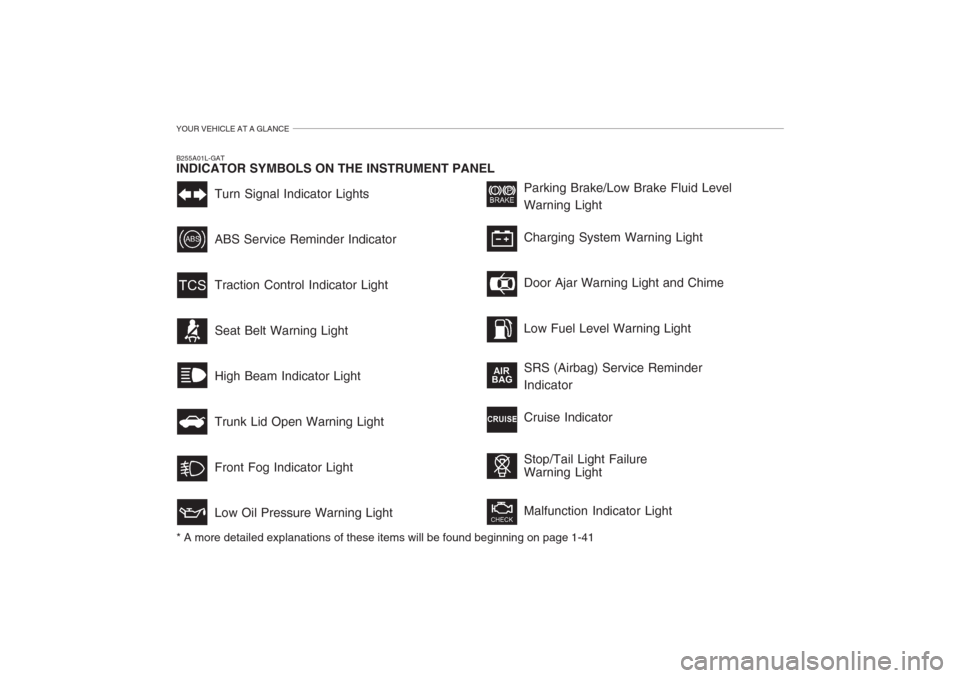
YOUR VEHICLE AT A GLANCE
Turn Signal Indicator Lights ABS Service Reminder Indicator Traction Control Indicator LightSeat Belt Warning Light High Beam Indicator Light Trunk Lid Open Warning LightFront Fog Indicator Light Low Oil Pressure Warning LightParking Brake/Low Brake Fluid Level Warning Light Charging System Warning Light Door Ajar Warning Light and Chime Low Fuel Level Warning Light SRS (Airbag) Service Reminder Indicator Cruise Indicator Stop/Tail Light Failure Warning Light Malfunction Indicator Light
B255A01L-GAT INDICATOR SYMBOLS ON THE INSTRUMENT PANEL * A more detailed explanations of these items will be found beginning on page 1-41
Page 16 of 230
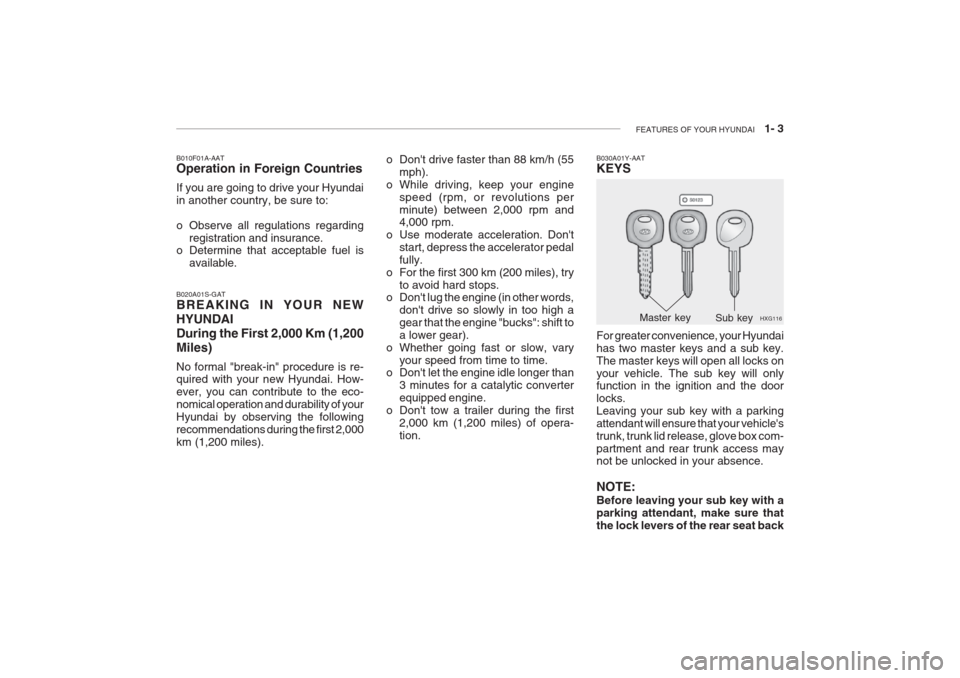
FEATURES OF YOUR HYUNDAI 1- 3
B010F01A-AAT Operation in Foreign Countries If you are going to drive your Hyundai in another country, be sure to:
o Observe all regulations regarding
registration and insurance.
o Determine that acceptable fuel is
available.
B020A01S-GAT BREAKING IN YOUR NEW HYUNDAIDuring the First 2,000 Km (1,200Miles) No formal "break-in" procedure is re- quired with your new Hyundai. How- ever, you can contribute to the eco-nomical operation and durability of yourHyundai by observing the followingrecommendations during the first 2,000km (1,200 miles). B030A01Y-AAT KEYS For greater convenience, your Hyundai has two master keys and a sub key.The master keys will open all locks onyour vehicle. The sub key will only function in the ignition and the door locks.Leaving your sub key with a parkingattendant will ensure that your vehicle'strunk, trunk lid release, glove box com-partment and rear trunk access may not be unlocked in your absence. NOTE: Before leaving your sub key with a parking attendant, make sure thatthe lock levers of the rear seat back
HXG116
Master key Sub key
o Don't drive faster than 88 km/h (55
mph).
o While driving, keep your engine speed (rpm, or revolutions per minute) between 2,000 rpm and 4,000 rpm.
o Use moderate acceleration. Don't start, depress the accelerator pedal fully.
o For the first 300 km (200 miles), try to avoid hard stops.
o Don't lug the engine (in other words,
don't drive so slowly in too high agear that the engine "bucks": shift toa lower gear).
o Whether going fast or slow, vary
your speed from time to time.
o Don't let the engine idle longer than
3 minutes for a catalytic converterequipped engine.
o Don't tow a trailer during the first 2,000 km (1,200 miles) of opera-tion.
Page 17 of 230
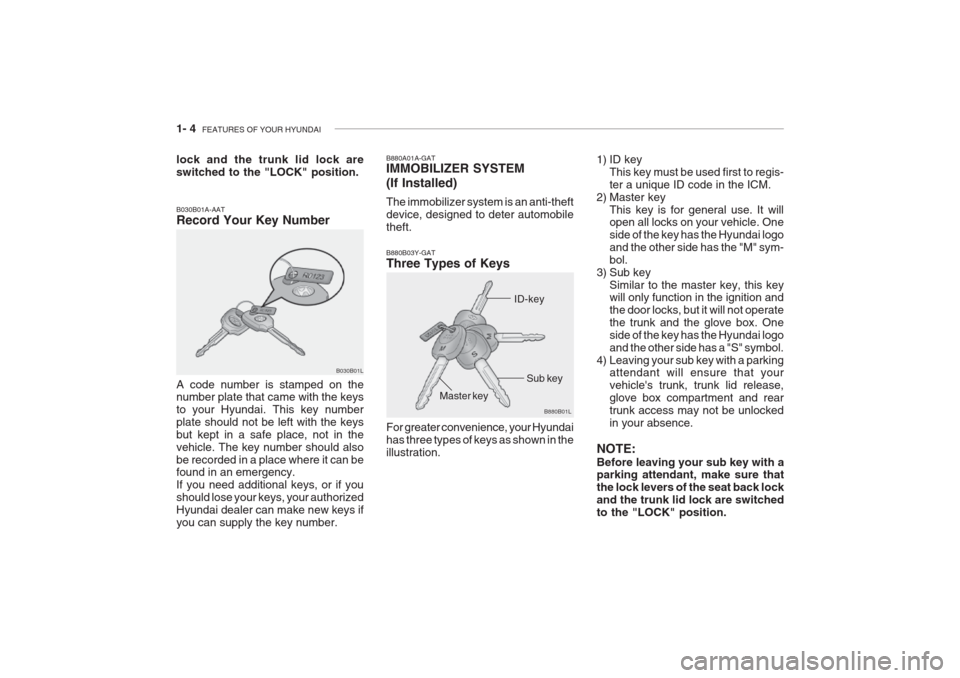
1- 4 FEATURES OF YOUR HYUNDAI
B030B01L B880A01A-GAT IMMOBILIZER SYSTEM (If Installed) The immobilizer system is an anti-theft device, designed to deter automobiletheft.
B030B01A-AAT Record Your Key Number A code number is stamped on the number plate that came with the keys to your Hyundai. This key numberplate should not be left with the keysbut kept in a safe place, not in thevehicle. The key number should alsobe recorded in a place where it can be found in an emergency. If you need additional keys, or if youshould lose your keys, your authorizedHyundai dealer can make new keys ifyou can supply the key number. B880B03Y-GAT Three Types of Keys
1) ID key
This key must be used first to regis- ter a unique ID code in the ICM.
2) Master key This key is for general use. It will open all locks on your vehicle. One side of the key has the Hyundai logoand the other side has the "M" sym-bol.
3) Sub key Similar to the master key, this key will only function in the ignition and the door locks, but it will not operatethe trunk and the glove box. Oneside of the key has the Hyundai logoand the other side has a "S" symbol.
4) Leaving your sub key with a parking attendant will ensure that yourvehicle's trunk, trunk lid release,glove box compartment and reartrunk access may not be unlockedin your absence.
NOTE: Before leaving your sub key with a parking attendant, make sure that the lock levers of the seat back lockand the trunk lid lock are switchedto the "LOCK" position.
For greater convenience, your Hyundaihas three types of keys as shown in theillustration. ID-key
Master key Sub key
B880B01L
lock and the trunk lid lock are switched to the "LOCK" position.
Page 36 of 230
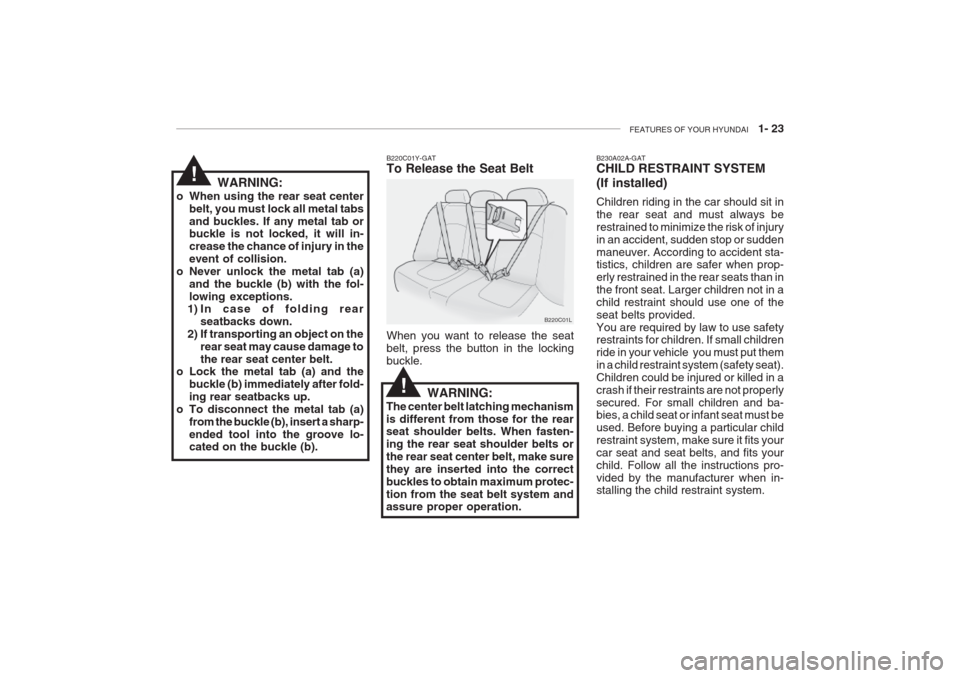
FEATURES OF YOUR HYUNDAI 1- 23
WARNING:
o When using the rear seat center belt, you must lock all metal tabs and buckles. If any metal tab or buckle is not locked, it will in- crease the chance of injury in theevent of collision.
o Never unlock the metal tab (a)
and the buckle (b) with the fol-lowing exceptions.
1) In case of folding rear
seatbacks down.
2) If transporting an object on the rear seat may cause damage tothe rear seat center belt.
o Lock the metal tab (a) and the
buckle (b) immediately after fold-ing rear seatbacks up.
o To disconnect the metal tab (a) from the buckle (b), insert a sharp-ended tool into the groove lo- cated on the buckle (b).!
B220C01L
B220C01Y-GAT To Release the Seat Belt When you want to release the seat belt, press the button in the lockingbuckle.
WARNING:
The center belt latching mechanismis different from those for the rear seat shoulder belts. When fasten- ing the rear seat shoulder belts orthe rear seat center belt, make surethey are inserted into the correctbuckles to obtain maximum protec-tion from the seat belt system and assure proper operation.
!
B230A02A-GAT CHILD RESTRAINT SYSTEM (If installed) Children riding in the car should sit in the rear seat and must always berestrained to minimize the risk of injuryin an accident, sudden stop or suddenmaneuver. According to accident sta- tistics, children are safer when prop- erly restrained in the rear seats than inthe front seat. Larger children not in achild restraint should use one of theseat belts provided.You are required by law to use safety restraints for children. If small children ride in your vehicle you must put themin a child restraint system (safety seat).Children could be injured or killed in acrash if their restraints are not properlysecured. For small children and ba- bies, a child seat or infant seat must be used. Before buying a particular childrestraint system, make sure it fits yourcar seat and seat belts, and fits yourchild. Follow all the instructions pro-vided by the manufacturer when in- stalling the child restraint system.
Page 54 of 230
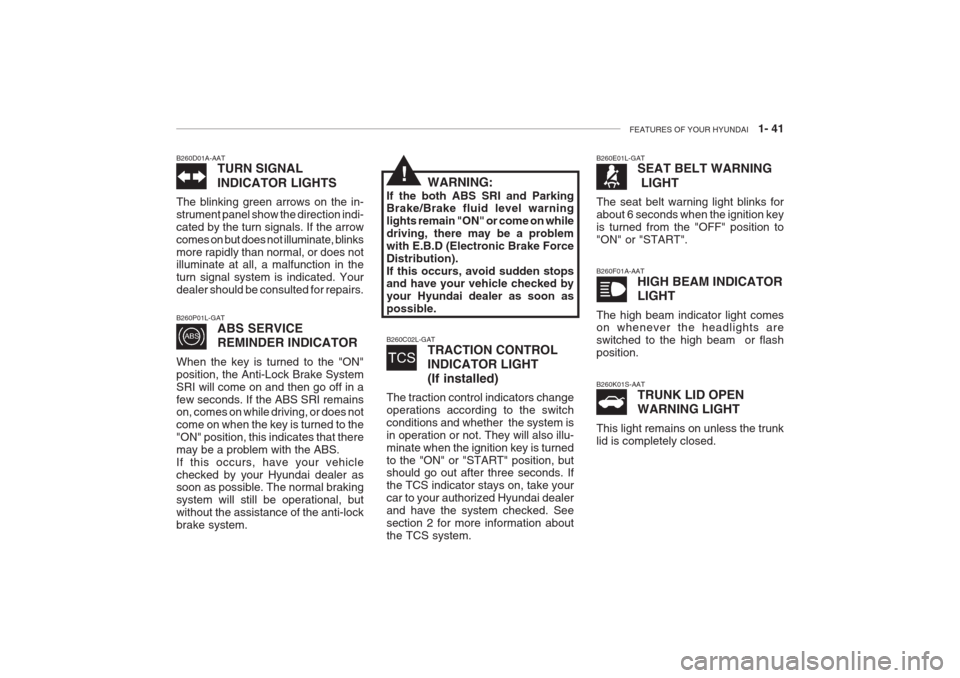
FEATURES OF YOUR HYUNDAI 1- 41
B260C02L-GAT
TRACTION CONTROL INDICATOR LIGHT(If installed)
The traction control indicators change operations according to the switchconditions and whether the system isin operation or not. They will also illu-minate when the ignition key is turnedto the "ON" or "START" position, but should go out after three seconds. If the TCS indicator stays on, take yourcar to your authorized Hyundai dealerand have the system checked. Seesection 2 for more information aboutthe TCS system.
B260D01A-AAT TURN SIGNAL INDICATOR LIGHTS
The blinking green arrows on the in- strument panel show the direction indi-cated by the turn signals. If the arrowcomes on but does not illuminate, blinksmore rapidly than normal, or does not illuminate at all, a malfunction in the turn signal system is indicated. Yourdealer should be consulted for repairs. B260F01A-AAT
HIGH BEAM INDICATOR LIGHT
The high beam indicator light comes on whenever the headlights are switched to the high beam or flashposition.
B260E01L-GAT
SEAT BELT WARNING LIGHT
The seat belt warning light blinks for about 6 seconds when the ignition keyis turned from the "OFF" position to"ON" or "START". B260K01S-AAT TRUNK LID OPEN WARNING LIGHT
This light remains on unless the trunk lid is completely closed.
B260P01L-GAT
ABS SERVICE REMINDER INDICATOR
When the key is turned to the "ON" position, the Anti-Lock Brake SystemSRI will come on and then go off in afew seconds. If the ABS SRI remains on, comes on while driving, or does not come on when the key is turned to the"ON" position, this indicates that theremay be a problem with the ABS.If this occurs, have your vehiclechecked by your Hyundai dealer as soon as possible. The normal braking system will still be operational, butwithout the assistance of the anti-lockbrake system. WARNING:
If the both ABS SRI and Parking Brake/Brake fluid level warning lights remain "ON" or come on whiledriving, there may be a problem
with E.B.D (Electronic Brake Force
Distribution).If this occurs, avoid sudden stops and have your vehicle checked by your Hyundai dealer as soon aspossible.
!
Page 130 of 230
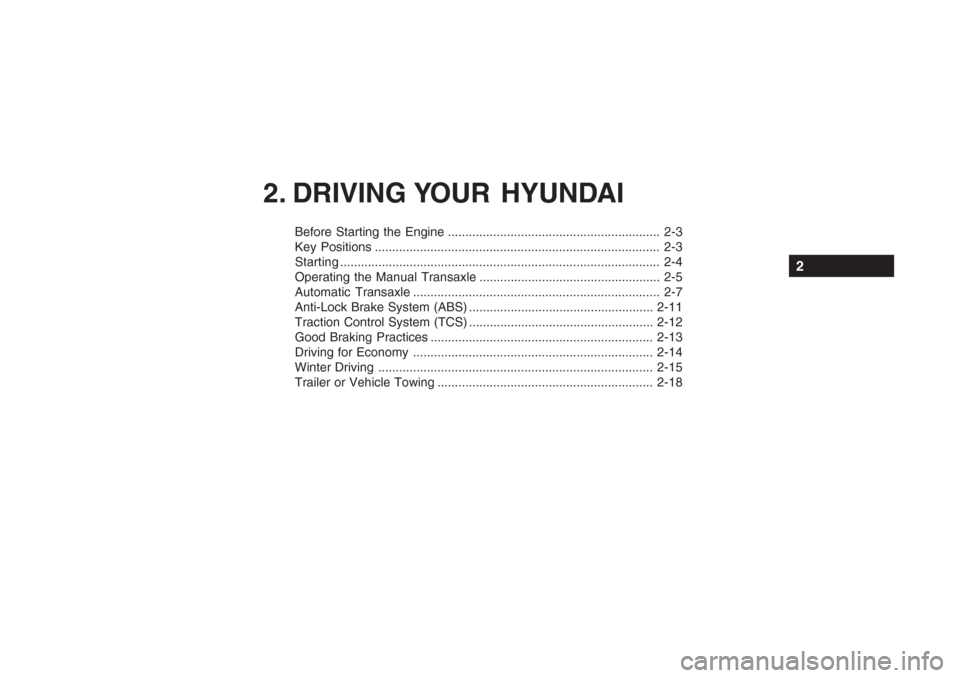
2. DRIVING YOUR HYUNDAI
Before Starting the Engine ............................................................. 2-3
Key Positions .................................................................................. 2-3Starting............................................................................................ 2-4
Operating the Manual Transaxle .................................................... 2-5
Automatic Transaxle ....................................................................... 2-7Anti-Lock Brake System ( ABS) .................................................... . 2-11
Traction Control System (TCS) ..................................................... 2-12
Good Braking Practices ................................................................ 2-13
Driving for Economy ..................................................................... 2-14
Winter Driving ............................................................................... 2-15
Trailer or Vehicle Towing .............................................................. 2-18
2
Page 140 of 230
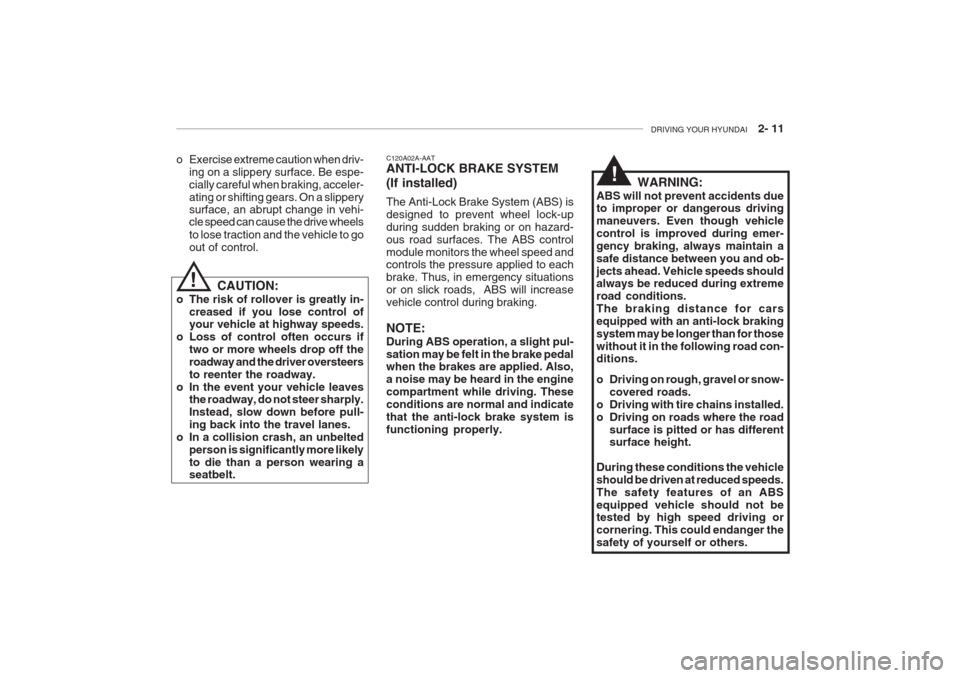
DRIVING YOUR HYUNDAI 2- 11
C120A02A-AAT ANTI-LOCK BRAKE SYSTEM (If installed) The Anti-Lock Brake System (ABS) is designed to prevent wheel lock-upduring sudden braking or on hazard-ous road surfaces. The ABS controlmodule monitors the wheel speed and controls the pressure applied to each brake. Thus, in emergency situationsor on slick roads, ABS will increasevehicle control during braking. NOTE: During ABS operation, a slight pul- sation may be felt in the brake pedal when the brakes are applied. Also, a noise may be heard in the enginecompartment while driving. Theseconditions are normal and indicatethat the anti-lock brake system isfunctioning properly. WARNING:
ABS will not prevent accidents due to improper or dangerous driving maneuvers. Even though vehiclecontrol is improved during emer-gency braking, always maintain asafe distance between you and ob-jects ahead. Vehicle speeds should always be reduced during extreme road conditions.The braking distance for carsequipped with an anti-lock brakingsystem may be longer than for thosewithout it in the following road con- ditions.
o Driving on rough, gravel or snow- covered roads.
o Driving with tire chains installed.
o Driving on roads where the road surface is pitted or has different surface height.
During these conditions the vehicle should be driven at reduced speeds.The safety features of an ABSequipped vehicle should not be tested by high speed driving or cornering. This could endanger thesafety of yourself or others.
o Exercise extreme caution when driv-
ing on a slippery surface. Be espe-cially careful when braking, acceler-ating or shifting gears. On a slipperysurface, an abrupt change in vehi- cle speed can cause the drive wheels to lose traction and the vehicle to goout of control.
CAUTION:
o The risk of rollover is greatly in- creased if you lose control of your vehicle at highway speeds.
o Loss of control often occurs if two or more wheels drop off the roadway and the driver oversteersto reenter the roadway.
o In the event your vehicle leaves the roadway, do not steer sharply.Instead, slow down before pull-ing back into the travel lanes.
o In a collision crash, an unbelted person is significantly more likelyto die than a person wearing a seatbelt.
!
!
Page 166 of 230
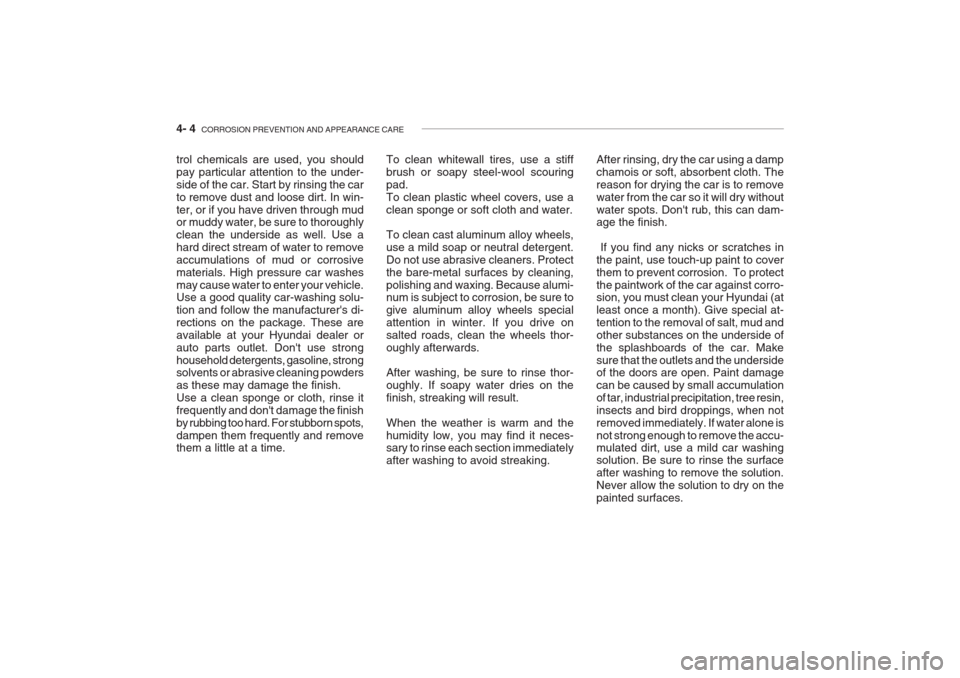
4- 4 CORROSION PREVENTION AND APPEARANCE CARE
trol chemicals are used, you should pay particular attention to the under-side of the car. Start by rinsing the carto remove dust and loose dirt. In win-ter, or if you have driven through mud or muddy water, be sure to thoroughly clean the underside as well. Use ahard direct stream of water to removeaccumulations of mud or corrosivematerials. High pressure car washesmay cause water to enter your vehicle. Use a good quality car-washing solu- tion and follow the manufacturer's di-rections on the package. These areavailable at your Hyundai dealer orauto parts outlet. Don't use stronghousehold detergents, gasoline, strong solvents or abrasive cleaning powders as these may damage the finish.Use a clean sponge or cloth, rinse itfrequently and don't damage the finishby rubbing too hard. For stubborn spots,dampen them frequently and remove them a little at a time. To clean whitewall tires, use a stiff brush or soapy steel-wool scouringpad.To clean plastic wheel covers, use aclean sponge or soft cloth and water. To clean cast aluminum alloy wheels, use a mild soap or neutral detergent.Do not use abrasive cleaners. Protectthe bare-metal surfaces by cleaning,polishing and waxing. Because alumi- num is subject to corrosion, be sure to give aluminum alloy wheels specialattention in winter. If you drive onsalted roads, clean the wheels thor-oughly afterwards. After washing, be sure to rinse thor- oughly. If soapy water dries on thefinish, streaking will result. When the weather is warm and the humidity low, you may find it neces- sary to rinse each section immediately after washing to avoid streaking. After rinsing, dry the car using a dampchamois or soft, absorbent cloth. Thereason for drying the car is to removewater from the car so it will dry withoutwater spots. Don't rub, this can dam- age the finish. If you find any nicks or scratches in the paint, use touch-up paint to coverthem to prevent corrosion. To protectthe paintwork of the car against corro- sion, you must clean your Hyundai (at least once a month). Give special at-tention to the removal of salt, mud andother substances on the underside ofthe splashboards of the car. Makesure that the outlets and the underside of the doors are open. Paint damage can be caused by small accumulationof tar, industrial precipitation, tree resin,insects and bird droppings, when notremoved immediately. If water alone isnot strong enough to remove the accu- mulated dirt, use a mild car washing solution. Be sure to rinse the surfaceafter washing to remove the solution.Never allow the solution to dry on thepainted surfaces.